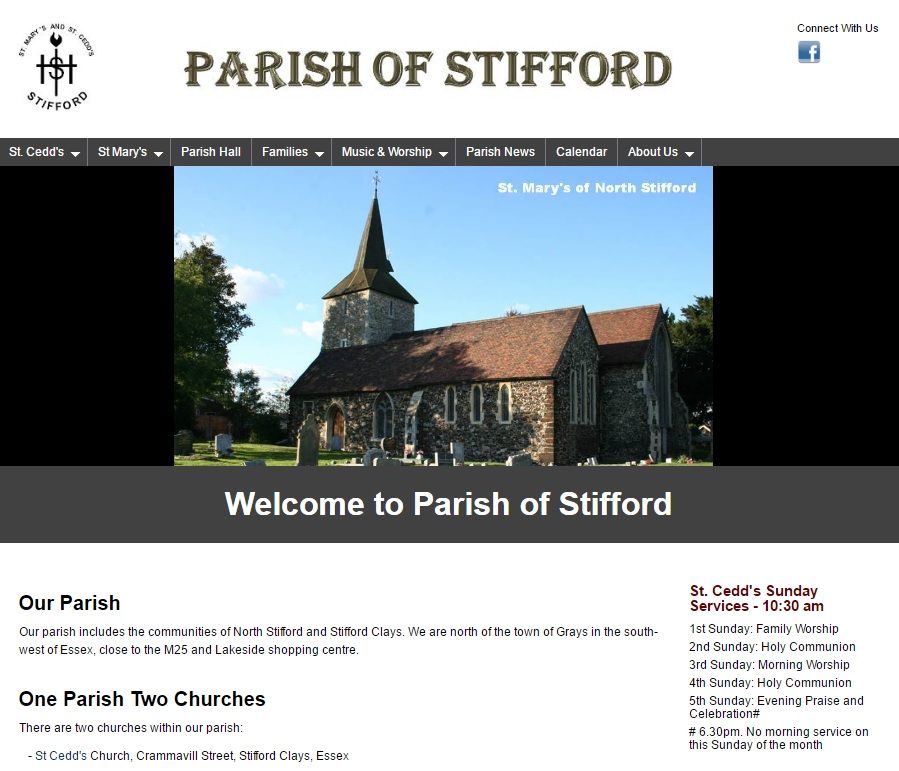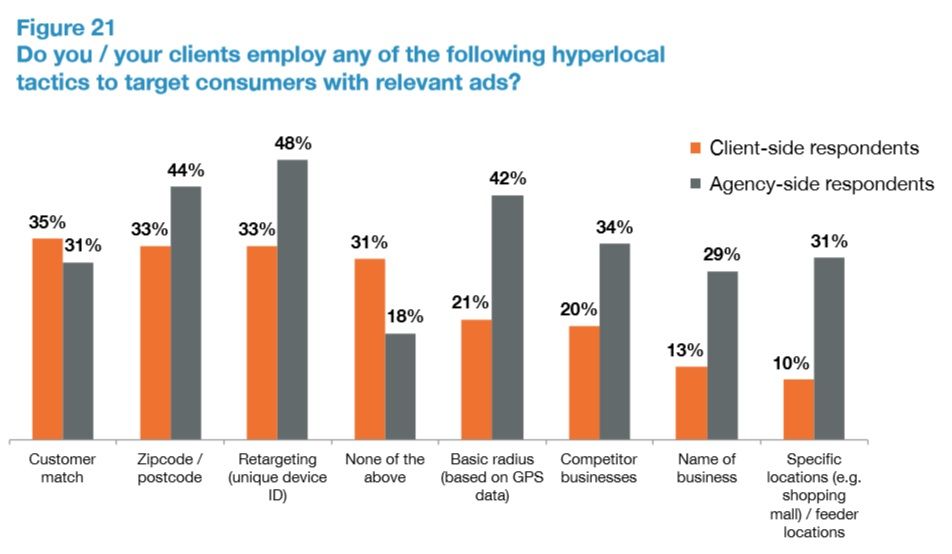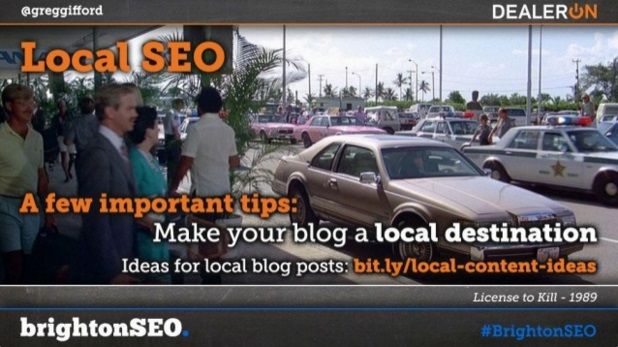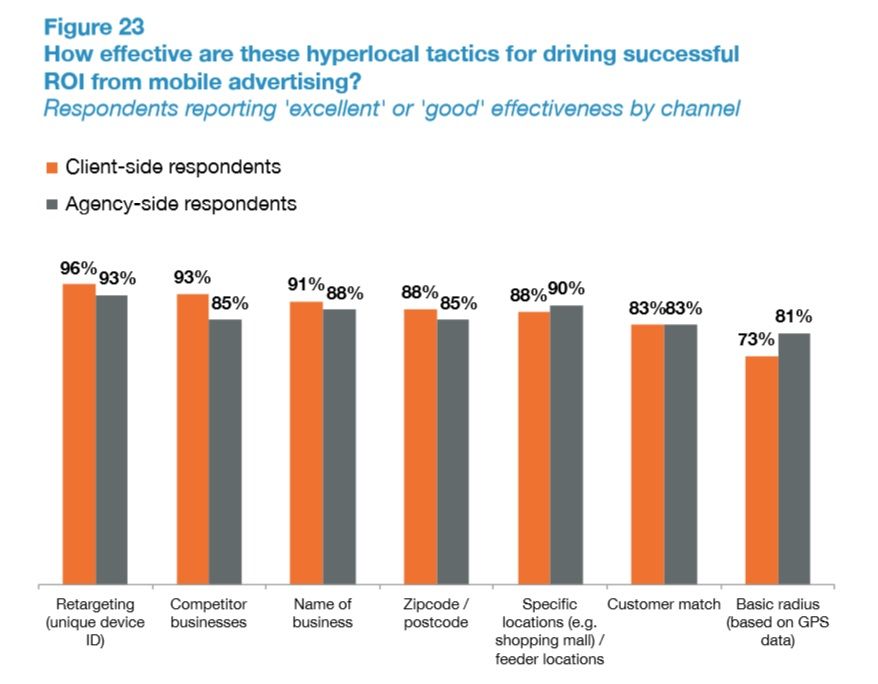Last month, ClickZ Intelligence published its report into ‘The State of Mobile Advertising’, in partnership with Search Optics.
Among the report’s findings was the revelation that mobile advertisers are missing out on hyperlocal opportunities in a big way. As our Editor in Chief Graham Charlton observed in the article linked, “With the near ubiquity of smartphones, and their growing use to access digital content, the opportunity to target based on location has never been greater.”
And yet, advertisers aren’t taking advantage of these opportunities to employ hyperlocal tactics in their advertising. When asked which of the hyperlocal tactics listed they used to target consumers with ads – including tactics like customer match, retargeting and basic radius based on GPS data – less than half of respondents said they were using any of the given strategies.
One survey respondent said, “Armed with their mobile devices, consumers are conducting ‘near me’ searches that require brands to be more responsive than ever. If your business is not present when near me moments of need occur, you might as well not exist.”
So how should businesses be stepping up their efforts to target consumers locally and be present at the top of search when it is most important? Here are six lessons that advertisers can learn from local SEO to make the most of these hyperlocal opportunities.
Be mobile-first
As the quote above neatly illustrates, mobile and hyperlocal go hand in hand like UX and SEO. As many as 94% of mobile searches are said to have local intent, and 50% of those are likely to visit a store within one day.
Mobile is an essential consideration for all digital businesses, as Google consistently ranks mobile-friendly sites above those which aren’t, and has even confirmed it is developing a separate mobile index (Read more...) searches carried out on mobile. Additionally, it was revealed at Google Performance Summit that more than half of the traffic for the millions of website owners using Google Analytics comes from smartphones and tablets.
 Designing for mobile increasingly means taking a mobile-first approach to user experience and content, rather than simply adapting to mobile.
Designing for mobile increasingly means taking a mobile-first approach to user experience and content, rather than simply adapting to mobile.
But designing for mobile doesn’t just mean designing a mobile ‘friendly’ or ‘responsive’ site any more. “Mobile First is mobile first,” asserts Salvador Carrillo, CEO of Mobile Dreams Factory, in the ClickZ Intelligence report ‘The DNA of a Great Mobile Commerce Site’. “If you have or will have more traffic in mobile, start designing in mobile.
“Responsive web is not simply about designing a liquid or adaptive multi-device site. You have to create a totally different experience in mobile.”
Don’t neglect your Google My Business listing
Paid ads aren’t the only way to be present at the top of search. The ‘map pack’ of local search results which appears near or at the top when users make a local search is composed of Google My Business listings, which are completely free to register and an easy way to ensure your business appears across Google’s services, including Maps and Google+.
These results are even more important on mobile, where it takes a significant amount of scrolling to move past the paid ads – where they appear – as well as the local map pack, making a presence in the local map pack almost equivalent to being on page one of organic search.
In our first #ClickZChat of May, ClickZ Chatters discussed local SEO, and specifically gave their thoughts on what the absolute basics are that marketers should be covering to achieve decent local SEO. Graham Charlton tweeted that marketers should be sure to claim their Google My Business listing:
Q2 – Google My Business listing. Easiest and cheaper way to increase your profile. #ClickZChat
— Graham Charlton (@gcharlton) May 4, 2016
Even if you’ve already claimed your listing on Google My Business, take a moment to check that the details are all updated, local and correctly categorised and that you’re using the best and most recent business images that you have.
We’ve put together a guide on how to optimise your Google My Business listing, with input from four experts in local SEO.
Publish regular, fresh and local content
A well-known tenet of SEO is that publishing fresh content is a great way to stay on top. Search engines treat up-to-date content as an indicator that the information contained on a website is more likely to be current, relevant and accurate and thus provide a better experience for users, and so they’re more likely to give it a higher ranking.
From a marketing perspective, content marketing done well can achieve excellent ROI, so there is a very solid marketing argument to be made for publishing relevant content as well. Publishing content fleshes out your business, giving it increased authority on the topics you publish about, and presents additional opportunities for consumers to engage with your business.
To boost your business’s local presence and relevance, you should also strive to make your content, or your blog, a local destination. Greg Gifford gave this advice during his presentation on winning the local visibility race at Brighton SEO, pointing out that a blog with thoughtfully curated local content can become a go-to destination, providing valuable information to visitors that isn’t just about the company (but is still relevant to its message), while also building strong links with other blogs and businesses in the process.
Twitter user JaroG4, during our local SEO #ClickZChat, also advised businesses to focus on relevant local events in their content in order to stand out and get noticed.
@sewatch Q2. From a content perspective, focusing on relevant events can also play a significant role in getting noticed #ClickZChat
— JaroG4 (@JaroG4) May 4, 2016
Go after local links
Building on from the previous point, publishing quality content can be very effective in building links with other local businesses and institutions – figurative links, as well as actual web links. As Jim Yu wrote in his piece for ClickZ about blogging and SEO, although backlinks have a bad reputation from the days of ‘black hat’ SEO, website owners shouldn’t be afraid to go after them. And links with a lot of local relevance can be particularly valuable.
In his presentation at Brighton SEO, Greg Gifford gave a clever tip for getting ahead in local visibility that most businesses wouldn’t think to do: go after ‘crappy little church website’ links, links with huge hyperlocal relevance that no-one else is pursuing.
Even if the websites themselves aren’t the most professional and don’t have a lot of domain authority, it doesn’t do to underestimate their importance in a local context. And you can build those entities (whether they’re churches, youth groups or local news blogs) as topics into your content, giving it local relevance at the same time as building relationships that benefit your business.
 Small, hyperlocal websites can wield a lot of local clout if you manage to gain links from them
Small, hyperlocal websites can wield a lot of local clout if you manage to gain links from them
If you’re worried about keeping on top of of the links you’ve gained or making sure you don’t have any that will harm your presence in search, read up on how to track your backlinks and how to deal with harmful backlinks that might hurt your ranking.
Make search ads relevant to context and location
Where you do place localised ads in search, it isn’t enough just to target them locally: consumers expect the advertising itself to be relevant to their context and location. A study by Google found that 4 in 5 consumers want ads that are “customised to their city, zip code or immediate surroundings”. As Google writes,
“By accounting for a consumer’s constantly changing location, all businesses can benefit, whether they are an online-only company looking to attract consumers in certain cities, a brick-and-mortar store trying to reach local consumers or a multichannel organization hoping to drive consumers from online to store.”
Image via Going Local: How Advertisers Can Extend Their Relevance With Search
Don’t take local visibility for granted
The overriding message from the ‘State of Mobile Advertising’ study as well as from all of these tips is simple: don’t overlook the importance of local visibility or take it for granted. Too many advertisers are neglecting opportunities to target consumers locally – opportunities which are demonstrably worth their while.
The ‘State of Mobile Advertising’ survey also found that where advertisers do employ local targeting techniques, regardless of what they are, the results are overwhelmingly positive. When asked how effective the hyperlocal tactics they used were for driving successful ROI from mobile advertising, the vast majority of advertisers (anywhere between 73 and 96%) rated their tactics “good” or “excellent” at driving ROI.
So the biggest lesson that advertisers can take away from local SEO is to not underestimate the importance of a local presence for your business. Local SEOs understand this, and advertisers should, too.
For more great insights, trends and best practice guides on digital marketing, head to ClickZ Intelligence and check out our library of reports.
Related reading
Last week we launched ClickZ Intelligence, a new service providing actionable insights into the worlds of digital marketing and ecommerce. One of ... read more
A look at why meta-descriptions are important, how to create one, and examples of good and bad practice.
Google is on track to make more than $70bn in revenue in 2016, and the lion’s share of that number will be generated ... read more
Last week, Google’s John Mueller confirmed on Twitter that Google’s latest, stronger Mobile Friendly Update has been fully rolled out. FYI The mobile ... read more







